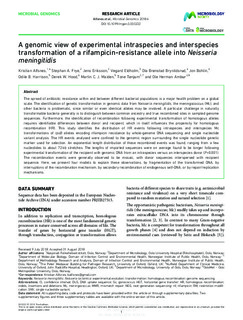| dc.contributor.author | Alfsnes, Kristian | |
| dc.contributor.author | Frye, Stephan Alfons | |
| dc.contributor.author | Eriksson, JE | |
| dc.contributor.author | Tonjum, Tone | |
| dc.contributor.author | Eldholm, Vegard | |
| dc.contributor.author | Brynildsrud, Ola Brønstad | |
| dc.contributor.author | Bohlin, Jon | |
| dc.contributor.author | Harrison, OB | |
| dc.contributor.author | Hood, D | |
| dc.contributor.author | Maiden, Martin C.J. | |
| dc.contributor.author | Ambur, Ole Herman | |
| dc.date.accessioned | 2018-10-10T11:55:52Z | |
| dc.date.available | 2018-10-10T11:55:52Z | |
| dc.date.created | 2018-10-03T18:55:00Z | |
| dc.date.issued | 2018 | |
| dc.identifier.issn | 2057-5858 | |
| dc.identifier.uri | http://hdl.handle.net/11250/2567424 | |
| dc.description.abstract | The spread of antibiotic resistance within and between different bacterial populations is a major health problem on a global scale. The identification of genetic transformation in genomic data from Neisseria meningitidis, the meningococcus (Mc), and other bacteria is problematic, since similar or even identical alleles may be involved. A particular challenge in naturally transformable bacteria generally is to distinguish between common ancestry and true recombined sites in sampled genome sequences. Furthermore, the identification of recombination following experimental transformation of homologous alleles requires identifiable differences between donor and recipient, which in itself influences the propensity for homologous recombination (HR). This study identifies the distribution of HR events following intraspecies and interspecies Mc transformations of rpoB alleles encoding rifampicin resistance by whole-genome DNA sequencing and single nucleotide variant analysis. The HR events analysed were confined to the genomic region surrounding the single nucleotide genetic marker used for selection. An exponential length distribution of these recombined events was found, ranging from a few nucleotides to about 72 kb stretches. The lengths of imported sequences were on average found to be longer following experimental transformation of the recipient with genomic DNA from an intraspecies versus an interspecies donor (P<0.001). The recombination events were generally observed to be mosaic, with donor sequences interspersed with recipient sequence. Here, we present four models to explain these observations, by fragmentation of the transformed DNA, by interruptions of the recombination mechanism, by secondary recombination of endogenous self-DNA, or by repair/replication mechanisms. | |
| dc.description.abstract | A genomic view of experimental intra- and interspecies transformation of a rifampicin resistance allele into Neisseria meningitidis | |
| dc.language.iso | eng | |
| dc.title | A genomic view of experimental intra- and interspecies transformation of a rifampicin resistance allele into Neisseria meningitidis | |
| dc.title.alternative | A genomic view of experimental intra- and interspecies transformation of a rifampicin resistance allele into Neisseria meningitidis | |
| dc.type | Peer reviewed | |
| dc.type | Journal article | |
| dc.description.version | publishedVersion | |
| dc.source.journal | Microbial Genomics | |
| dc.identifier.doi | 10.1099/mgen.0.000222 | |
| dc.identifier.cristin | 1617708 | |
| cristin.unitcode | 7502,4,19,0 | |
| cristin.unitname | Avdeling for infeksjonsepidemiologi og modellering | |
| cristin.ispublished | true | |
| cristin.fulltext | original | |
| cristin.qualitycode | 1 | |
